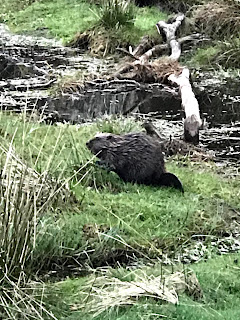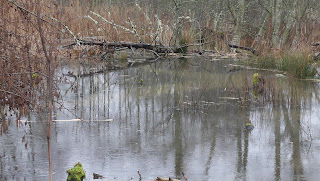Summer’s lease hath all too short a date.
Beavers at Bamff
A riparian and wetland rewilding project at Bamff in Perthshire, Scotland in which Eurasian beavers (Castor fiber) play a key part.
Tuesday, 15 December 2020
Summer's lease hath all too short a date.
Thursday, 18 June 2020
June 2020
18th June.
Here is a piece that I wrote for July's 'Alyth Voice', but didn't send because something more exciting came up and I decided to write that up and send it in as my contribution.
The WhatsApp message announced itself with a ‘Ping!’ The message was brief it said get your act together and produce something for the ‘Voice’. Of course I must do that: so it’s on with the boots, stick at the ready and, with my binoculars around my neck, I stride out. Beyond the herbaceous border of Bishop’s weed in full bloom I pass the row of lime trees at whose feet a bank of Siberian Purslane displays its pink flowers. This species is described as being originally from western North America, not Siberia as its scientific name, Montia sibirica (Claytonia sibirica is a synonym), suggests, but I see from its entry in Wikipedia that its range does include the Commander Islands, the westernmost of the Aleutian Islands in the Bering Straits. Striding past this gathering of incomers, which have been here since the eighteenth century (their leaves are good in salads,) there is an assembly of yellow flowered Wood Avens, some of whose stems are decorated with cuckoo spit. I wonder if I will see any of this plant’s near relation the Water Avens with its drooping head and pinky purple flower - I am sure that there are some further down the drive. These two species are closely enough related to hybridise freely, which always seems odd to me because, superficially at least, the flowers look so different. Past the trees, the drive side verge is grassed out. We are at that time of year when grasses, particularly the agricultural species, are reaching the peak of their annual growth and coming into flower. I notice some Timothy whose stamens are heavy with golden pollen, waiting to be carried away by the wind.
Left along the Burnieshead path: yesterday evening wrens were cacophonous. The young were trying out their wings. A week before Greater spotted woodpecker fledglings were making a tremendous noise up in their hole in a dead sycamore tree: their parents were flying about the nest, apparently distracted by their offspring. The woodpeckers are quiet now. I suppose the young have fledged and flown. On the water the mallard duck with her brood of seven continues to supervise their activities. A couple of weeks ago I watched with amazement as the ducklings attacked a hatch of mayflies, or some other aquatic invertebrate. They darted about snapping at the insects. A few days later I saw them busy again, hunting for something on the surface. Some were upending. It was as though they were getting lessons in hunting and gathering. All the while their mother sailed along, watchful and attentive. In the meantime the moorhen pair still have one of their first brood of chicks, the other six having disappeared. Otters were around at the time of this disappearance and I haven’t seen them since. I wondered if the moorhens would try to breed again. One evening I saw a couple of young with one of the adults.
The ferns are now fully grown. It is a pleasure to see a beaver swim over to the bank and then, some moments later, swim back to the lodge with ferns trailing from its mouth. I used to think that ferns were good only for bedding, but I have learned that the male fern (Dryopteris files-mas), one of our commonest species, is valuable nutritionally. I walk on. A roe doe in her brilliant summer coat of chestnut red bounds out of the young regenerating birch. Bumble bees forage in the broom and foxgloves are massing in the clearings, ready to burst into purple and white.
Walking back up the drive after the circuit that has taken me by the Old Drove Road, a new bicycle path through the Steffort Woods and on to Cold Corner, I see Water Avens flowering and scattered groups of columnar purple bugle. All through the beaver wetlands along the drive the willow and birch regeneration is flourishing. The yellow flag will be out soon and I notice knapweed readying itself to flower. The seasons advance. It is high summer.
Saturday, 2 May 2020
Spring 2020
Tuesday, 7 April 2020
More walks
Sunday, 22 March 2020
Time for a Catch Up
Sunday, 11 February 2018
The following is a letter that we are sending friends of the beaver and our Scottish Wild Beaver Group members.
It would be good to give a really strong signal to the Scottish Government that we should protect this returned native.
Dear Beaver friend / SWBG supporter
Soon the legislation allowing beavers to remain in Scotland will be debated in the Edinburgh Parliament. Before that can happen, the Scottish Government is obliged to issue a report and hold a public consultation on the conclusions of that report. The report was issued in December 2017 and the consultation is now underway.
If you want beavers to remain in Scotland, please could you contribute your views to the 5 substantive questions in the consultation which can be found at the following link:
The government report on beavers in Scotland is technical and lengthy. So to make responding to the 5 questions easier, we set out below a summary of the answers that Scottish Wild Beaver Group has provided to the consultation. You should of course, feel free to respond to the questions as you see fit. If you feel uncomfortable or unqualified to answer any particular question, we suggest you just leave it blank.
Kind regards
Louise Ramsay
Convener Scottish Wild Beaver Group
Question 1
Do you agree with the re-introduction policy and that the Environmental Report has correctly identified the potential impacts and appropriate mitigation?
-Yes ✔
-No
-Unsure
Please explain your answer
We strongly agree that beaver populations in Scotland should be allowed to remain,and that beavers should receive strong legal protection.
Beaver bring many benefits such as flood risk reduction, improved water quality and increased biodiversity.
In addition their presence has socio-economic benefits (such as ecotourism potential)
Beavers should be actively managed to reduce any negative effects on farmers, but culling should only ever be a very last resort after all other mitigation methods have been exhausted
Question 2.
What are your views on the evidence set out in the Environmental Report that has been used to inform the assessment process?
Very positive
-Positive ✔
-Neutral
-Negative
Very Negative
Please give details of additional relevant sources:
Question 3
What are your views on the predicted environmental effects as set out in the Environmental Report? See page 15 and Section 4
Very positive
Positive ✔
Neutral
Negative
Very Negative
Please explain your answer
The report’s findings on the predicted environmental effects of beaver reintroduction are generally comprehensive and well reasoned.
Question 4
Are there any other environmental effects that have not been considered?
The creation of riparian buffer zones (involving beaver dams) could potentially provide a critical solution to combatting agricultural run-off pollution in intensively farmed areas.
Question 5
Please provide any other comments you have on the environmental reportThe environmental Report has correctly identified the the potential impacts and appropriate mitigation – but it will be critical to see how the identified mitigation measures are implemented in practice, that sufficient funding is made available for beaver management, and that any evidence of wildlife crime involving beavers is swiftly investigated and prosecuted.

























